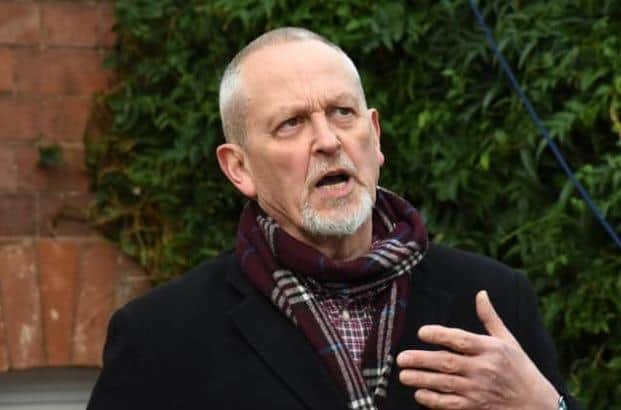The basement in Leamington where The Specials recorded Ghost Town - one of the most iconic pieces of 20th century pop music


A plaque now stands at a building in Leamington where musical history was made.
Back in 1981, The Specials - the groundbreaking, Coventry-based two-tone and ska revival band - recorded their UK number 1 song Ghost Town at 27 Woodbine Street, the original location of the Woodbine Street Recording Studio.
Advertisement
Hide AdAdvertisement
Hide AdIn 1973, John Rivers bought 27 Woodbine Street because “it was the cheapest house in Leamington".


It had all the problems of old houses, but it also had a redeeming feature, one that would change his life forever: a cold, dark, damp, windowless cellar.
John’s passion was music. He learned to play the piano when he was four years old and, as a teenager, played keyboards and drums in local bands.
After leaving school, John was a professional musician until the age of 22, when he became a computer engineer.
Advertisement
Hide AdAdvertisement
Hide AdHaving been fascinated with recording since he built his first tape recorder aged 14, John bought an old Sony valve tape recorder and started recording musician friends in the front room of his new house.


His growing reputation led to more ambitious recordings with even more musicians.
Realising that this could be his future career, in 1975 he bought a 4-track tape machine to improve the quality of his recordings.
The problem was that the front room was too small to cope with the increasing number of musicians and the complexity of John’s recordings.
Advertisement
Hide AdAdvertisement
Hide AdThe solution lay in the cellar which he set about converting into a basement recording studio.
John said: "I lined the brick walls with two-inch by one-inch blocks of wood and put fibre board on top, which was nearly one inch thick and very absorbent and non-resonant.
While the floor was carpeted concrete, the ceiling was marine ply and I put dry sand in there to add soundproofing, as well as a great big rolled steel joist across the centre to stop it all sagging.
"The ceiling height of that cellar was ridiculous but I couldn’t afford to do anything crazy like taking the floor out and raising the head room.
Advertisement
Hide AdAdvertisement
Hide Ad"It must have measured about six foot four by 12 foot by 10 foot – I can’t believe anybody wanted to work in there.”
John soon became a full-time music producer.
He reinvested his income into new recording equipment and in 1979 he made the leap from 4-track to 8-track with the acquisition of a Soundcraft Magnetics recorder and mixing desk – costing the equivalent price of a decent new car.
John’s new studio was incredibly successful with many new artists recording there, including The Shapes, Swell Maps and Eyeless in Gaza.
However, the studio’s growing reputation did not depend on technology, acoustics or location, but on John’s reputation as a producer who cared about artists and the music they wanted to make.
Advertisement
Hide AdAdvertisement
Hide AdMost groups recorded playing “live”, squashed together in the studio’s tiny space.
However, this was not possible in the case of the most famous group to record there, The Specials.
It was physically impossible for all seven members of the group to perform together, so each was recorded separately in the studio.
The result was Ghost Town - 'one of the most evocative and provocative singles of all time and 'a graphic depiction of the inner-city deprivation and urban unrest prevalent throughout the UK in the early 1980s'.
Advertisement
Hide AdAdvertisement
Hide AdHorace Panter, bass player in The Specials said: “In an era when eye-watering amounts of money were being spent on recording at residential studios in the Bahamas on state-of-the-art multi-track machines in rooms the size of tennis courts, The Specials recorded one of the most iconic pieces of 20th century pop music in a studio in the basement of a small Victorian house in Leamington.
"It was not only a snub to the unnecessary extravagance of the music industry, but a homage to the music that influenced us.
"All our favourite early reggae songs were recorded quickly and cheaply.
"Woodbine was the local studio with a growing reputation and fitted the bill.
Advertisement
Hide AdAdvertisement
Hide Ad"Not only was Ghost Town a great piece of music, it had a different sound, and this was due, in no small part, to the studio in which it was recorded and to the engineering skills of its owner, John.”
Ghost Town was The Specials’s most successful single ever, spending three weeks at No 1 in July 1981.
However, the ten day session in John’s studio was the last time that The Specials would record together as they separated later that year.
In 2009, some members of the band reunited and they continue to perform as The Specials to this day.
Ghost Town will always be their encore.
That year, 1981, was also a year of change for John.
Advertisement
Hide AdAdvertisement
Hide AdHe built a new, larger, Woodbine Street Recording Studio in St Mary’s Crescent nearby where he continues to produce music for a wide variety of artists.
In December 2021, a Special Interest Plaque was unveiled outside the house. To mark this, members of the band, Horace Panter and Neville Staple, attended the event where Leamington Mayor Cllr Susan Rasmussen did the honours of unveiling the plaque and giving a speech.